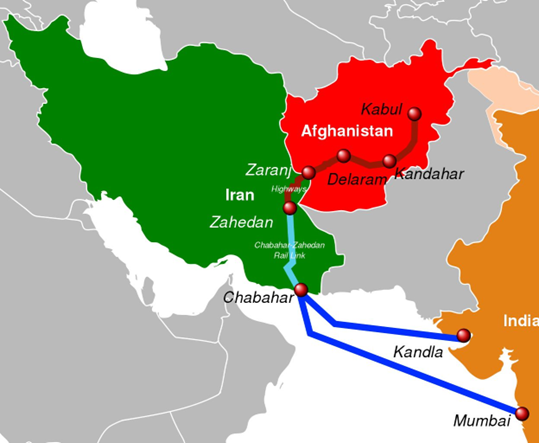STAY INVESTED: ON CHABAHAR AND INDIA-IRAN TIES
Relevance: GS 2 – Bilateral, regional and global groupings and agreements involving India and/or affecting, India’s interests; Effect of policies and politics of developed and developing countries on India’s interests.
Why in the news?
- India should not tailor its ties with Iran to U.S. foreign policy changes.
- Eight years after concluding the general framework of cooperation on the Chabahar port in Iran, India and Iran signed a 10-year contract for India’s operation.
- The long-term agreement was signed between Indian Ports Global Ltd. (IPGL) and Iran’s Port and Maritime Organisation (PMO).
About the agreement
- India signed a 10-year agreement with Iran to develop and operate the Chabahar port.
- The deal advances India’s infrastructure and trade partnership with Iran despite regional tensions.
- This agreement enables the operation of the Shahid-Behesti terminal.
- IPGL will invest approximately $120 million in equipping the port.
- India has also offered a credit window equivalent to $250 million for mutually identified projects aimed at improving Chabahar-related infrastructure.
History of Chabahar Project
- Conceived in 2003, the project stalled due to U.S. and UN sanctions over Iran’s nuclear program.
- India signed an MoU in 2015 after the U.S. eased sanctions following the nuclear agreement.
- In 2016, the contract was executed during Prime Minister Narendra Modi’s visit to Iran.
U.S. Sanctions and Reactions
- The U.S. State Department warned that entities engaging with Iran risk potential sanctions. Past American sanctions on Iran had delayed the Chabahar port project.
- The U.S. has viewed the Chabahar project narrowly due to its hostile stance towards Iran.
- Changed Interests: In 2018, the U.S. supported the project with a sanctions waiver when its forces were backing the Islamic Republic in Afghanistan, as Kabul benefited from the port.
- However, theS. withdrew from Afghanistan, the Taliban took over, and the U.S. shifted focus to containing Iran.
- Challenges and Developments
- The U.S. unilaterally withdrew from the nuclear deal in 2018 and reimposed sanctions on Iran.
- This raised questions about India’s continued cooperation with Iran.
- India secured a carve-out from U.S. sanctions, allowing it to operate the port through ad hoc measures.
- The U.S. unilaterally withdrew from the nuclear deal in 2018 and reimposed sanctions on Iran.
Strategic Importance of Chabahar Port
- Connectivity: The Chabahar port is critical for India’s plans to improve connectivity with Afghanistan and Central Asia by bypassing Pakistan, enhancing trade opportunities.
- International North-South Transport Corridor (NSTC): Chabahar is expected to connect to the NSTC, which will link India to Europe via Iran, Azerbaijan, and Russia. This corridor offers an alternative to the Suez Canal route, potentially reducing costs and transit times for intercontinental trade.
- Geopolitical Influence: Located roughly 200 km from Pakistan’s Gwadar port (developed by China as part of the Belt and Road Initiative), Chabahar allows India to expand its geopolitical influence in Central Asia.
India’s Approach
India has previously adjusted its engagement with Iran based on U.S. policy changes. India should avoid future U-turns and remain committed to the Chabahar project.
- Prioritize National Interests: India should clearly define its goals in the relationship, focusing on energy security, regional stability (especially in Afghanistan), and trade benefits.
- Compartmentalize Diplomacy: Maintain strong ties with the US while underlining the independent nature of India’s foreign policy with Iran. Open communication with both parties is key.
- Utilize Alternative Payment Mechanisms: Explore options like rupee-rial trade bypassing dollar-dominated transactions to mitigate the impact of US sanctions.
- Focus on Mutually Beneficial Projects: The Chabahar port development, crucial for Afghan connectivity, is a prime example. Emphasize such projects to showcase the strategic value of India-Iran cooperation.
- Engage Multilaterally: Seek common ground with Iran on issues like regional security and counter-terrorism within frameworks like the Shanghai Cooperation Organization (SCO).
- Maintain Open Channels with Iran: Regular diplomatic dialogue is essential to address concerns and build trust despite US pressure.
- Diversify Energy Sources: While Iran remains a significant oil supplier, India should invest in alternative sources to lessen dependence and appease US anxieties.
- Advocate for Peaceful Resolution: India can leverage its good relations with both sides to encourage dialogue and a diplomatic solution to the Iranian nuclear program issue.
Associate articles:
Mains question
Discuss the strategic significance of the Chabahar port for India and analyze how India can navigate its relations with Iran amidst challenges posed by U.S. sanctions. (250 words)




